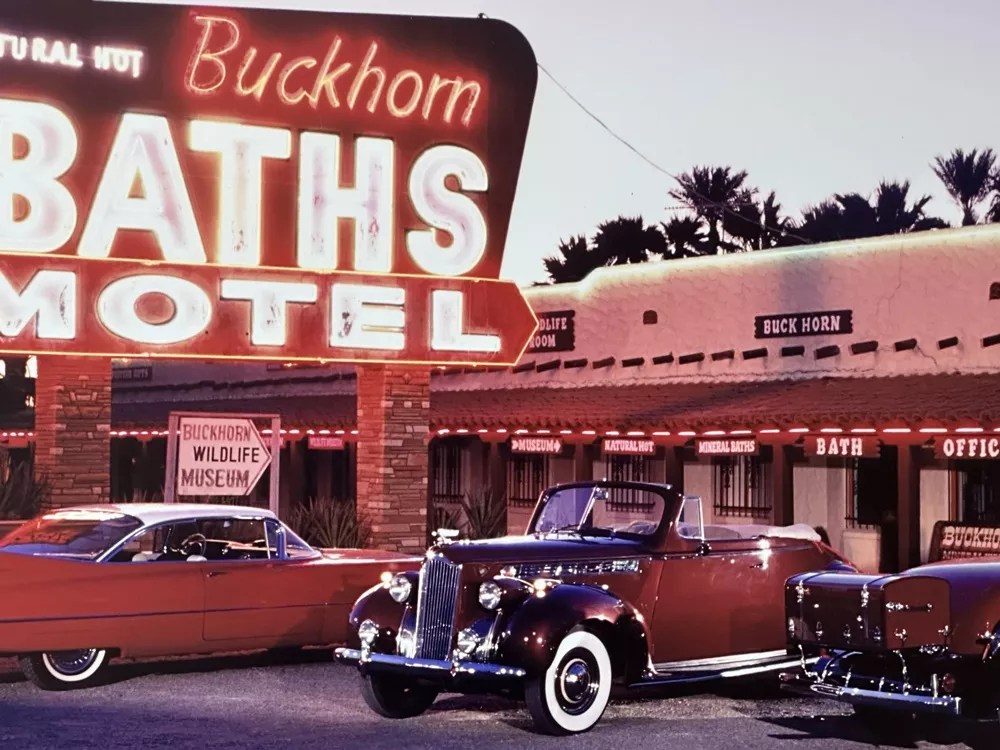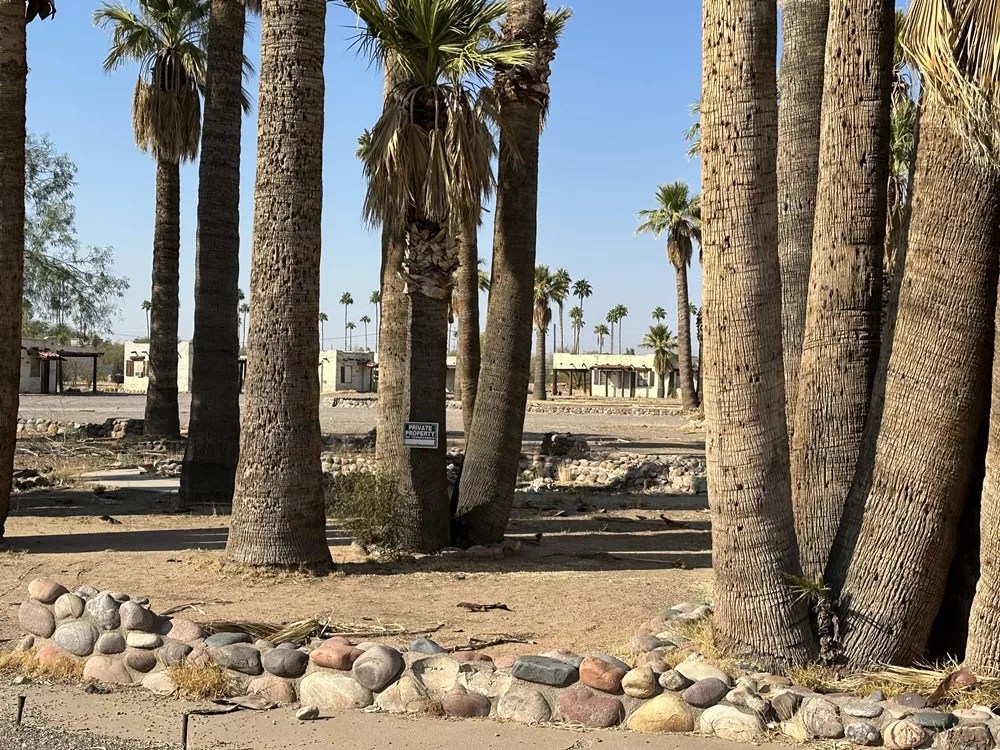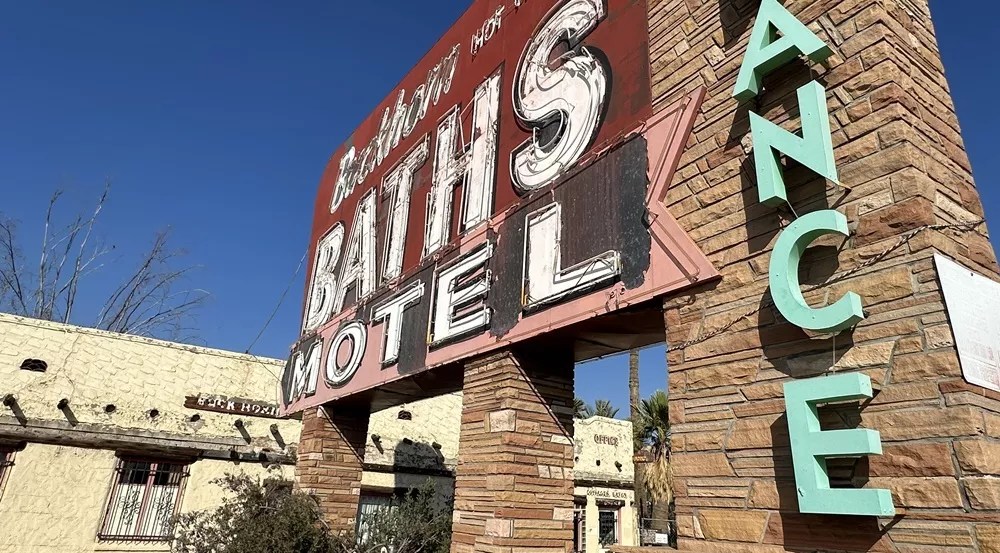
Mesa Historical Museum

Audio By Carbonatix
For years, the Buckhorn Baths have been a fixture on Main Street in east Mesa. Its huge neon sign, now aged and faded, still stands tall among the ruins. Some might call it an eyesore; desert vegetation has taken back its hold of the landscape and the brickwork of the surrounding buildings has begun to erode after decades of desert sun and wind.
But this once-flourishing tourist destination is an important part of local history, and now through July 2024, you can learn about the “Desert Spa of International Fame” known as the Buckhorn Baths at the Mesa Historical Museum.
To understand how the baths came to be, you have to travel back to the Depression era. Mesa was just a little town back then, its roads barely paved as steel-roofed Chryslers and Ford touring sedans moved along the roads kicking up dust. Travelers who could afford cars would often take road trips across the country that took them through Arizona’s Salt River Valley. Along those routes were roadside attractions, mainly motels and other rest stops that were themed to grab a driver’s attention.
During that time, newlyweds Ted and Alice Sliger lived in the Valley. Ted was a talented taxidermist and Alice was a schoolteacher. They owned a successful gas station in Mesa, but in 1935, the station caught fire from a candle Ted was using to heat wax for one of his projects. The aftermath left nothing of the building or the couple’s livelihood. After a while, they secured some land on Main Street (then Apache Trail), and brick by brick, they began to rebuild their lives.
In 1939, while digging a well on their new property, the Sligers discovered something that would change their lives and the city of Mesa forever: a mineral-fortified hot spring. The temperature of the water was around 112 degrees. The Sligers, knowing they had something special, built their first bathhouses around the wells, and a desert tourist attraction was born.
They added Pueblo Revival style cottages, enough for over 70 visitors, plus a cafe and dining room, a beauty shop, a gas station and a standard 18-hole golf course.
They called it Buckhorn, in honor of Ted’s taxidermy projects. Not only were the baths a popular attraction among tourists, but the Sligers also became respected members of the community.

The historic Buckhorn Baths Motel in Mesa has now fallen into disrepair.
Timothy Rawles
The baths had become a landmark by the time Ted died in 1984. Alice, who died in 2010, continued to run the motel until she sold it in 1999. The resort would get three more owners, but never regained its once prominent place among the Mesa landscape.
Today, the Sligers’ dream seems almost like a roadside ghost town on Main Street. The 1,562-acre property remains precariously intact, the adobe visages of the cabins and reception office cracking and crumbling back into the desert sand. The huge midcentury sign located at the entrance has survived the elements as a reminder of the Sligers’ vision of hospitality.
That vision is remembered in an exhibit dedicated to the Buckhorn at the Mesa Historical Museum. It’s filled with memorabilia and mementos from the once-popular tourist attraction. Several placards and items placed along the museum walls and antique tables tell its story and offer glimpses of its fate.
Susan Ricci, executive director of the Mesa Historical Museum says the exhibit exists for a couple of reasons.
“First, the issue of the Buckhorn Baths’ current state of limbo is a concern for many of our visitors and people in the community,” she says. “We are often asked about what is happening to the property. Secondly, Ted and Alice Sliger are Cactus League Hall of Fame inductees and we host the Cactus League Hall of Fame exhibit here at our museum.”
The future of the baths has not been decided yet as both the new owner, Aktar Verma, and the city of Mesa are at odds over how the property should be developed. Verma says that he wants to add apartments to the land and possibly preserve the Buckhorn’s historic buildings. The city is okay with that, but they question exactly how Verma will preserve the historic elements among the blueprints.
During one meeting, Verma’s representatives suggested that the historical status of the Buckhorn be removed and the entire parcel be redeveloped. It’s an ongoing dispute that leaves the future of the historic spa up in the air.

The Buckhorn Baths Motel sign can still be seen in east Mesa.
Timothy Rawles
But nobody can take away the legacy that the Sligers left in Mesa. Their story is one of perseverance, luck and rising from the ashes. The Mesa Historical Museum would like to remember the importance of the Buckhorn, but mostly how this couple capitalized on the rising tourism of the 1950s and, in a way, made Mesa the dominant city it is today.
“The Sligers were and still are icons in this city and we wanted to share their story with everyone,” Ricci says. “Recently we received some grant funding to digitize many of their home videos and we have them on display within the exhibit.”
Nine miles away from the museum, tourists can still see the Buckhorn Baths on Main Street near Recker Road. The huge broken and fading neon sign reminds passersby of a time when American motorists traveled through the Southwest looking to get away from the hustle and bustle of their everyday lives. Curious explorers can pull into the driveway near the sign at their own risk, but if you decide to go any farther be warned, it is still private property and the caretaker may scare you away.
The Buckhorn Baths exhibit runs through July 2024 at Mesa Historical Museum, located at 2345 N. Horne in Mesa. Hours are 10 a.m. to 4 p.m. Tuesday through Saturday.